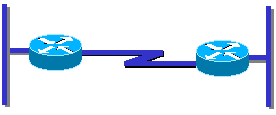VLSM is used to help in the management of IP addresses, in that it will allow you to set the subnet mask to the size that makes the most sense based on the link or segment requirements. What does that mean? Well, lets think about how addresses would be allocated if VLSM is not used. Say you have a network with two LAN segments tied together via a WAN link.

Lets say that the LAN segments have a requirement of 250 hosts each and both need to be part of the same Class B network. If the routers are using a classful routing protocol (and therefore not able to support VLSM), the WAN link would need to be a subnet of the same Class B network (assuming that you are not using ip unnumbered). Without VLSM, the WAN link would have to have the same subnet mask as the LAN segments. A mask that would support 250 hosts is 24 bits (255.255.255.0). The WAN link only needs 2 (one for each router), therefore there would be 252 addresses wasted.
The same scenario with VLSM would be that we could have a 24 bit mask (254 hosts) for the LAN segments, but use a 30 bit mask (2 hosts) for the WAN link. All using the same Class B network.
In the following scenarios, there will be multiple levels of requirements and you will need to come up with a solution (if available) for all levels. To setup a consistent set of answers, let set a few ground rules (in real life there could be many different, correct answers).
1. Stay away from the zero subnet, unless there is no other solution.
2. Allocate the largest requirements first from the address range.
3. Allocate the subnets in binary order within each range.
4. Allocate the next level after all requirements are meet for the higher level(s).
5. Levels should be put from largest requirement to smallest requirement
a. Example: Campus of 2000devices would be before a WAN link of 2 devices.
6. NO OVERLAP!
For more information or if you have any questions please e-mail me:
Johnny Bass
Copyright: Bass Consulting Services, Inc. 2011
Bass Consulting, BCS Pro Audio and BCS Productions are all trade names
of Bass Consulting Services, Inc
All photographs, recipes, formulas, charts, et al are property of
Bass Consulting Services, Inc and Johnny Bass, use by permission only,
all rights reserved.
The links and pages contained
herein remain the property of the respective authors.
The logos and trademarks
contained herein remain the property of the respective
companies and organizations to
which the links are pointed. I am not responsible
for failure to link to the
pages listed. Please refer to the organizations' home
pages for further information.
No warranties or guarantees are implied or intended.